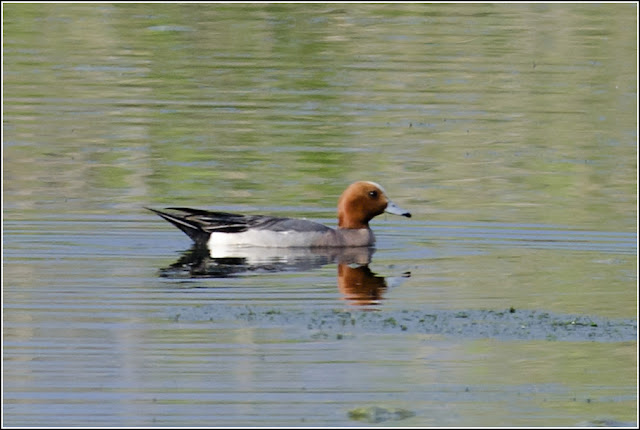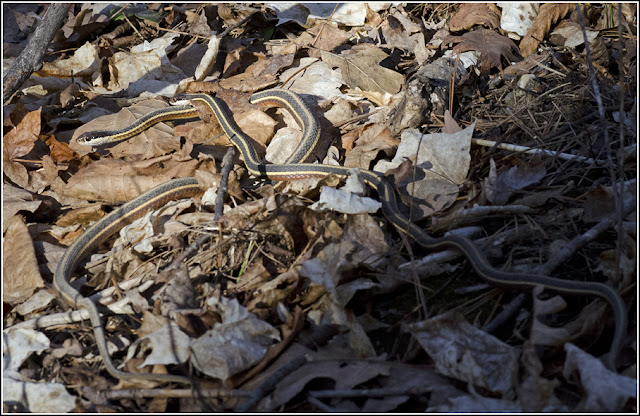On the Saturday morning the forecast had held and the winds were fairly strong out of the south, shifting to the southwest as the morning wore on. Dark clouds and scattered precipitation fell to the north, west and south, but fortunately the precipitation stayed clear of Point Pelee until later in the day. The tip watch during the autumn at Pelee can be excellent, though you really have to put in the time if you expect to see a lot of good birds! Todd and I joined Alan Wormington, Blake Mann, Jeremy Hatt and Jeremy Bensette at an opening through the shrubbery along the west side of the tip, sheltered from the strong winds. In the few hours that we were there a big flight of waterbirds never materialized, and the Bonaparte's Gulls that were flying passed by several kilometers out, making it difficult to pick up any rarities that might have joined them. At one point I noticed a distant adult Little Gull with the Bonaparte's flock, one of the highlights of the relatively slow morning. Unfortunately no Sabine's Gulls or Long-tailed Jaegers passed by; two species I have yet to see at Point Pelee.Occasional shorebirds winged by heading south including a few Sanderlings as well as a flock of 16 medium sized birds, which we determined to be Stilt Sandpipers. There may have been a Lesser Yellowlegs mixed in as well. This was quite unexpected - I don't think I've ever seen more than about 8 Stilt Sandpipers in one spot before, and never a pure flock flying by.
Sanderlings are often seen flying by the tip, occasionally alighting on the sandy tip of Point Pelee. A small group of juveniles were working the sand on the east side of the tip both mornings.
 |
| Sanderlings - Point Pelee National Park |
Saturday was windy and overcast with a constant threat of rain, making it difficult to turn up good numbers of warblers and other songbirds. What we could find was staying hidden in the cedars and leafy shrubbery, living in constant fear of the Sharp-shinned Hawks which had infiltrated the park in good numbers. I walked around with Todd and it wasn't until mid afternoon at DeLaurier that we found our first warblers of the day.
Fortunately a new crop of birds had arrived in the park overnight, and Sunday morning was relatively calm and sunny with north winds, great conditions to beat the bushes for birds! Heading down to the tip we were distracted by the large numbers of Monarchs that flitted in the treetops or flew out over the lake.
 |
| Monarch - Point Pelee National Park |
Several large clusters of Monarchs were also in the tip area with several hundred butterflies in the largest. Apparently the evening before some of the clusters were in the thousands.
 |
| Monarchs - Point Pelee National Park |
 |
| Monarchs - Point Pelee National Park |
The north winds had pushed many raptors over the park as well, and as the day grew warmer we noticed many Broad-winged and Sharp-shinned Hawks, along with the odd Northern Harrier or Cooper's Hawk. This sharpie briefly landed in a tree in front of Brandon Holden and I while we were photographing flyover Monarchs. I was a second too late to catch the bird on the branch before it darted away.
 |
| Sharp-shinned Hawk - Point Pelee National Park |
The birding ended up being quite good in the tip area and Todd and I joined Steve Pike, Lindsey Galliant and Jeremy Hatt. Groups of warblers were staying hidden in the shrubbery or moving quickly through the bushes feeding, but with some effort we were able to tease out around fifteen species. At one point I got on a Prairie Warbler with a small flock of Palm Warblers for about 2 seconds. By the time I had called it out to the others the bird had ducked out of sight. We were unable to turn it up again that morning, though the bird was seen by others the following day. Jeremy Bensette also found a female Cerulean Warbler, but searching for it was like looking for a needle in a haystack. Only a small percentage of the birds present we were able to get a good enough look at to identify, a combination of the extensive foliage, raptor presence overhead, and good foraging conditions for the birds. It was quite pleasant walking around and having a lot of birds to look at, however! Nashville Warblers and House Wrens in particular were quite numerous on the day. The first White-crowned Sparrows and Yellow-bellied Sapsuckers were in, a sign of the inevitable change in diversity that was coming in the weeks ahead. Jeremy Hatt, Todd and I also flushed a roosting Eastern Whip-poor-will which landed deep in a thicket, providing semi-obscured views of its cryptic plumage before it flew further back out of sight. Looking at my notes I had never seen one in September before.
Raptors and Monarchs were not the only winged creatures migrating south in the good conditions; dragonflies too were quite numerous. One of the more common species was Black Saddlebags. This individual was powering up in a sunny spot.
 |
| Black Saddlebags - Point Pelee National Park |
As the songbird activity died down as the day grew warmer, some of us headed to our favorite hawk watching site in Leamington. Hawks were moving, but often at a height that made them inperceivable to the naked eye. If you looked through your bins, distant Sharp-shinned Hawks and Broad-winged Hawks could sometimes be identified. Bald Eagles cruised by occasion, and a single Peregrine Falcon made a pass.
 |
| Peregrine Falcon - Leamington |
Soon after we packed up and headed back with a brief stop at the Blenheim lagoons thrown in for good measure. It was a great weekend at Point Pelee with good friends during a gorgeous autumn weekend.




































